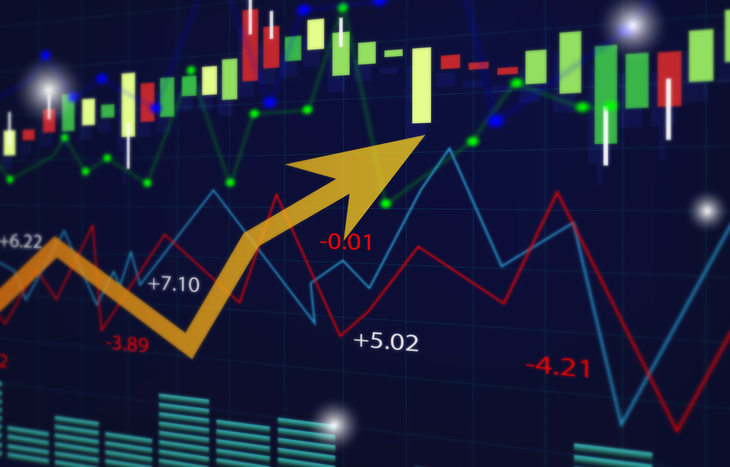Trend Trading Capitalizes on Market Momentums
Trend trading seeks to capitalize on the momentum of a security’s price, depending on its direction. It’s more than opening a long position because of an uptrend or shorting on the downtrend, though. There’s a degree of technical analysis behind trend trading that makes it scientific, instead of merely speculative. You’re not just following the trend: you’re predicting it.

What is Trend Trading?
A trend represents momentum. In simplest terms, a trend is the sentiment behind the movement of a security. If a stock price falls five days in a row, it’s on a downtrend. Whether it’s falling on bad earnings, news, investor sentiment or something else, the negative momentum is what creates the trend. It’s the same for an uptrend.
Trends can occur in neat patterns, or in messy channels; qualifying the trend comes down to framing it. A stock price might zig-zag up and down as it tests new support and resistance levels. However, if it generally moves up and to the right, it’s an uptrend. Conversely, a trend might see huge price spikes and troughs. Yet, if it gradually moves down, it’s on the downtrend.
Keep in mind that trend trading is all about momentum. Two or three pips on a stock chart might signal gathering momentum. But that’s not enough to call out a trend. Usually, four or more points signify a trend. This is why most basic trend patterns have roots in the ABCD pattern: four distinct points that, together, show momentum.
Where to Look For Trends
Trends can occur over any length of time, from intraday trends to month-long trends and beyond. To spot a trend, you’ll need to look at a chart—and, depending on the chart you look at, you might find different trends. For example, a line chart will show specific price trends in the context of the market. A candlestick chart shows day-to-day price trends for a single security.
You can also spot trends in the context of a single security, within an index or as part of a sector. For example, if an entire sector is down while the market is up, it’s important to consult a security’s movement within the context of both.
Lastly, you can spot trends in the context of patterns. Triangles, wedges, flags and more are all modes of assessing trends in context. The more complex the pattern, the more complex the trend. Remember, trends don’t always go straight up or straight down. Patterns help contextualize them.
How to Qualify a Trend
So how do you qualify a trend? There are several important avenues traders can explore to get context for a trend they’re seeing on the stock chart.
- Patterns: As we’ve already discussed, patterns are the best way to add context to trend trading. The simplest way to do this is to understand whether it’s a continuation, reversal or bilateral trend, and what type of pattern, specifically, it is. Established patterns provide insight into the direction of the trend and what movement will look like as it continues.
- Technical Analysis: Behind every trend and pattern is a slew of technical data. Traders need to look at everything from volume to Fibonacci ratios, depending on the pattern. Good technical analysis will provide even more context in determining the reason for price momentum and the efficacy of the trend.
- Trend Lines: One of the simplest ways to distinguish a trend and begin mapping a pattern is to chart trend lines. Connect support and resistance peaks to form the beginnings of a pattern. The steeper the slope of the trend line, the more aggressive it is.
- Moving Averages: Akin to a trend line, a moving average is a simple depiction of trend. It represents pricing information that’s smoothed out over a period of time relevant to a trader’s interests. Many traders will use trailing moving averages to provide context for the current momentum of a security.
A trend isn’t a trend until you can qualify it as one. Sometimes, that’s as easy as looking at a few pips on a graph. Other times, it means thorough technical analysis. In either case, qualifying the trend is the first step to more accurate trading against it.
Short and Long Positions Depend on Trend
There’s a reason pattern trading and trend trading go hand-in-hand. Trend traders aim to capitalize on a stock’s momentum. So, they rely on patterns to contextualize that momentum. This is key in determining whether to take a short or long position in reference to the trend.
For example, a trend might show a security moving up and to the right, indicating a bullish uptrend. The untrained investor might take out a long position to capitalize. However, technical analysis might reveal a reversal pattern, indicating a short position is the better bet. For this reason, it’s best to identify trends, then qualify them. You can have a downtrend on a bullish reversal pattern or a downtrend on a bearish continuation pattern—you won’t know until you qualify it.
Capitalize on Trend Trading
To capitalize on trend trading, follow this important series of actions. First, identify the beginnings of a trend. Second, contextualize the trend with a pattern. Third, perform technical analysis to qualify the trend. Finally, set your price targets and stop loss based on how you believe the trend will play out.
At Profit Trends, the experts do the research and analysis so you don’t have to. Sign up for the Profit Trends e-letter below for trending stock insights and tips.
While every trader will approach their research with their own means and methods, what’s important is that they perform every step. Without them, trend trading can trend into speculation.





